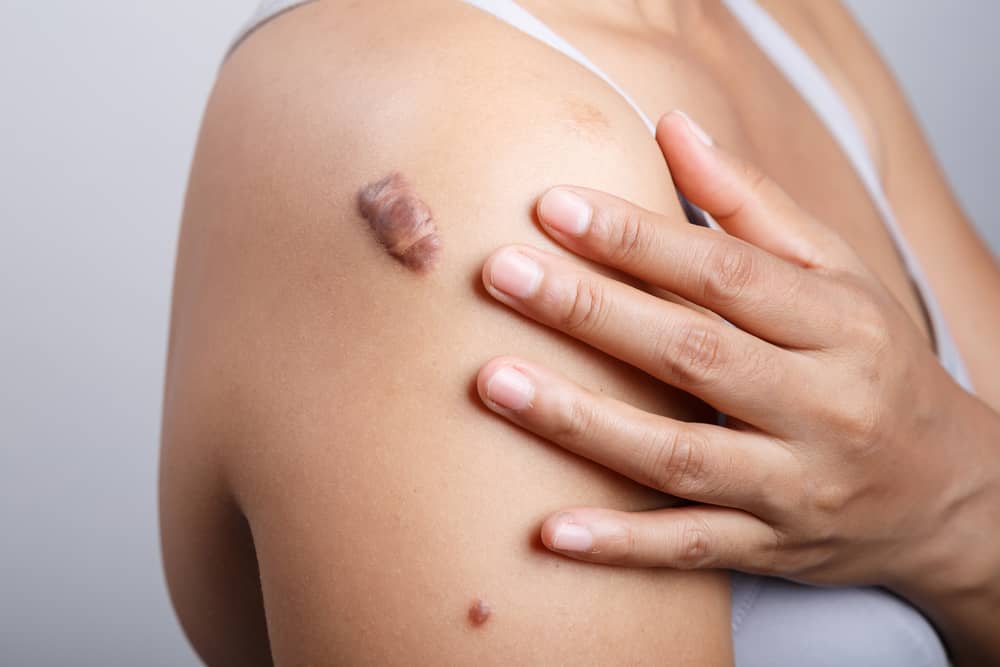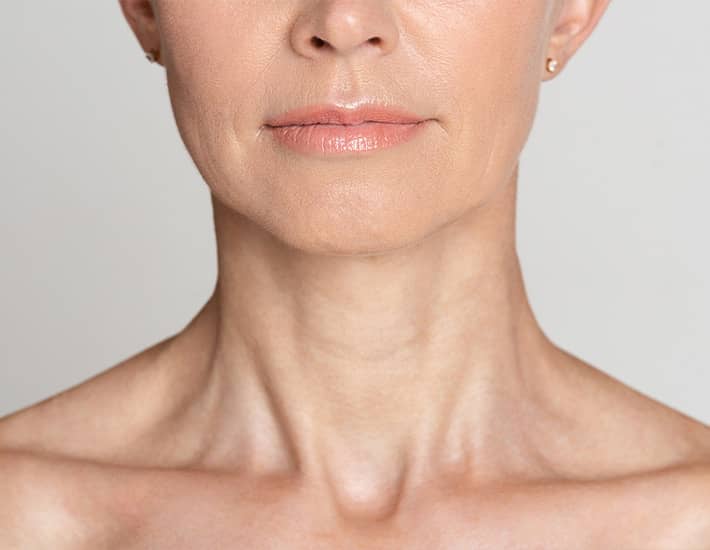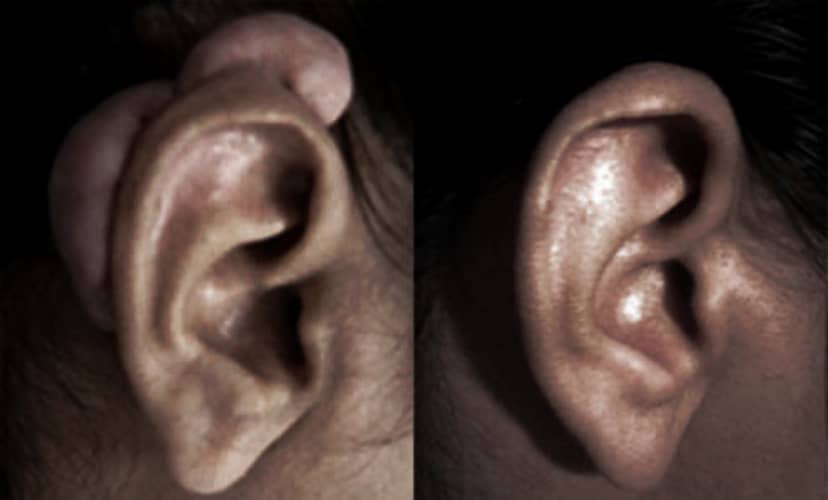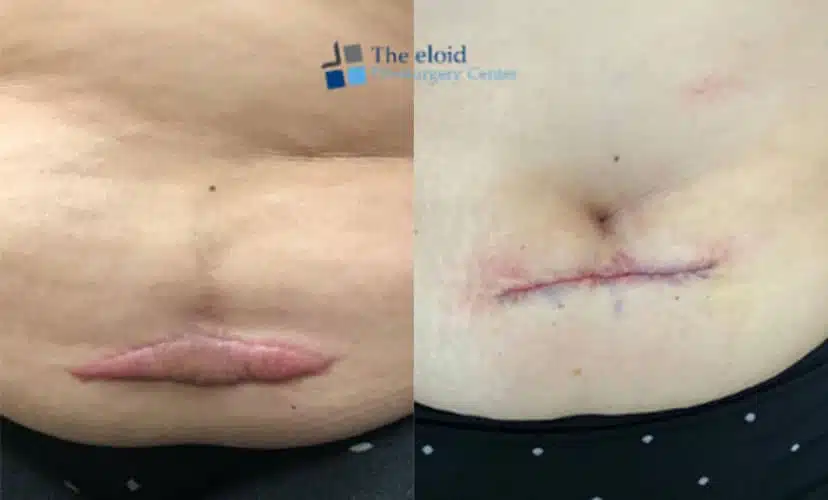Despite their visually alarming appearance, keloids are nothing more than overgrown scar tissue that develops where the skin has healed after an injury, cut, or scrape. No one knows exactly why some people seem to be more likely to get keloids than others. But there’s evidence that overproduction of collagen – the protein responsible for skin elasticity – during the healing process, may increase the chances of keloid scarring.
Since keloids are formed due to an abnormal response to wound healing, surgical removal alone is not always the best option for removing them. Creating a new incision to extract the keloid can stimulate the formation of even more scar tissue, resulting in a new, sometimes larger keloid increasing keloid recurrence rates.
Fortunately, there are other effective treatments of keloid scar modalities for its management with satisfactory recurrence rates. At The Keloid Plastic Surgery Center, we offer a wide range of options, including surgical excision, silicon sheeting, superficial radiation therapy (S.R.T.), a minimally-invasive procedure that has been proven to yield the highest cure rate (over 95%) of any available treatment for keloid modalities.

- How Does Superficial Radiation Therapy Work For Keloids?
- Types of Keloids treated with Superficial Radiation Therapy
- Candidates For Superficial Radiation Therapy for Keloids
- Benefits of Superficial Radiation Therapy
- Consultation for Radiation Treatment of Keloid Scars
- The S.R.T. Procedure
- Superficial Radiation Therapy for Keloids Recovery and Aftercare
- Side Effects and Risks of Superficial Radiation Therapy for Keloids
- Frequently Asked Questions about Superficial Radiation Therapy for Keloids
How does Work
How Does Superficial Radiation Therapy Work For Keloids?
Superficial radiation therapy (S.R.T.) is a non-invasive treatment option for the removal of keloids and hypertrophic scars. S.R.T. uses X-rays to destroy abnormal tissue cells, thereby reducing the appearance of the initial wound and hypertrophic scars. This type of radiation therapy works well for hypertrophic keloids because it delivers a concentrated dose of radiation to the affected area. The goal is to destroy the excess tissue and stop further growth with great treatment outcomes.

S.R.T. is often used as a non-surgical skin cancer treatment. When treating squamous cell carcinoma and basal cell carcinoma, doctors use high doses of radiation to kill the cancer cells while sparing surrounding healthy tissues. That’s why S.R.T. has a high rate of success when it comes to treating non-melanoma skin cancer signs.
Keloids, which are not cancerous, are raised, red, scaly skin growths that occur when scar tissue grows too quickly after injury. They’re often painful and unsightly.

TYPES OF KELOIDS
Types of Keloids treated with Superficial Radiation Therapy
There are two types of keloids that can be treated with S.R.T: primary and secondary.
Primary Keloids
Primary keloids occur when there is no previous history of keloids. They tend to grow faster than secondary keloids.
Secondary Keloids
Secondary keloids develop after a person has had keloids previously. These types of keloids often require multiple treatments.
Although keloids are not cancerous, they can cause discomfort and embarrassment, and there is always a keloid scar recurrence. S.R.T. as a keloid treatment modality, works well because it destroys only the top layer of skin cells. This means that the underlying layers of healthy skin remain intact, allowing them to heal naturally over time.
Candidates
Candidates For Superficial Radiation Therapy for Keloids
If you’ve never had keloids, you may not need S.R.T. However, if you’ve already tried topical treatments and laser therapy, S.R.T. may be worth considering.
You may be an excellent candidate for keloid scar removal with S.R.T. if:
- You are bothered by the appearance of keloids or scars
- You have an area of scar tissue that itches or is tender or painful when you touch it
- The area has grown well beyond the size of the original injury or wound
- You are in relatively good health

S.R.T. works well as an alternative for patients who have keloids. However, some patients may not respond to S.R.T. because their keloids were too large or deep.
The best way of determining whether you’re a good candidate for S.R.T. and the right combination of therapies for your keloid is to schedule a consultation at The Keloid Plastic Surgery Center. During your initial consultation, one of our board-certified plastic and reconstructive surgeons will thoroughly examine your skin and create a personalized treatment plan to help you achieve the results that you want. Click (Opens in a new tab) here to get started.
BEFORE & AFTER GALLERY
Natural & Unparalleled Results
Surgeries performed by renowned plastic surgeon Roberto J. Mendez M.D. and double board-certified plastic surgeon Dr. Gabriel Salloum in Miami Beach, FL
Contact
Schedule A Consultation Today
If you want to treat a visible scar or reduce a keloid scar volume, contact us at The Keloid Plastic Surgery Center today to schedule a consultation today and learn how SRT will help you get rid of those unsightly keloids in as little as three sessions. You can also discuss the keloid radiation therapy cost and other alternatives to surgery with us. Our board-certified plastic and reconstructive surgeons have successfully treated keloids of all sizes and complexities in patients across the United States and the world, and are eager to help you restore your self-confidence and improve your quality of life.

Benefits
Benefits of Superficial Radiation Therapy
Keloids are common among people who have had surgery, particularly plastic surgery. They’re most often found on the face, neck, chest, back, arms, legs, hands, feet, buttocks, breasts, and genitals.
People with keloids may feel self-conscious because of their appearance. Some people avoid social situations due to embarrassment. Others find it hard to sleep at night because of itching.
In addition to treating keloids, Superficial (low-radiation) Radiation Therapy can also be used to treat non-melanoma skin cancers such as squamous cell carcinoma and basal cell carcinoma. It is especially useful in treating superficial or small areas of these cancers, and it is often the most cost-effective solution.
S.R.T. works by targeting cancer cells with a low dose of radiation that penetrates only the affected area, minimizing damage to surrounding healthy tissue. The treatment typically requires three or four short sessions scheduled several weeks apart for optimal results.
S.R.T. as one of the most innovative treatments of keloids provides excellent results. There are many benefits of SRT for keloid removal, including:
- 95% and a higher cure rate
- Short treatment (typically about three sessions are needed to achieve impressive results)
- Appropriate for all skin types
- No significant side effects
- Appropriate for patients of all ages
- Painless procedure
- Low recurrence rate (less than 10%)
- No downtime or aftercare
CONSULTATION
Consultation for Radiation Treatment of Keloid Scars
When consulting a board-certified plastic and reconstructive surgeon for keloid removal, they will discuss the risks of keloid removal. They will also examine the patient to determine which treatment planning is most appropriate, as well as any alternatives, such as S.R.T. and surgery. Patients with keloids should be aware that these scars can recur even after successful treatment, so it’s important to follow all post-treatment instructions.
S.R.T. is often recommended for smaller keloids, while surgical procedures may be best for larger ones. In certain cases, a combination of both may be suggested for optimal results. It’s important to discuss any potential risks and benefits with your doctor before beginning any type of treatment.
During your consultation, ask your doctor about the radiation therapy modalities he recommends as well as the radiation doses. And if you’ve had radiotherapy for keloids before, ask your doctor about possible side effects. He may recommend taking certain vitamins or supplements to help prevent these problems.
Preparing for your Superficial Radiation Therapy for Keloids Consultation
Treatments for keloids require radiation therapy. The goal of this effective treatment is to reduce the size of the keloid scar tissue. Keloids are raised scars that grow over skin that has been injured. As we already mentioned, they’re often painful and unsightly.
Radiation therapy works by damaging DNA within cells. This causes cell death and reduces the growth of the keloid.
To prepare for your consultation, you should bring along any photos of your keloid scar. Also, be prepared to answer questions about your medical history, including previous treatment of keloids and medications.
PROCEDURE
The S.R.T. Procedure
Keloid scars are raised, thickened areas of scar tissue that form after surgery or trauma. While they don’t cause permanent damage, they can be unsightly and uncomfortable. Fortunately, the prevention of keloids is possible thanks to S.R.T. without any health risk.
As part of the keloid radiotherapy protocol, it is important to protect fragile organs like the thyroid and mammary glands to avoid adverse effects. Therefore, during the first session, a protective lead shield is placed between the keloid and the body’s organs.
After the first session, the lead shield is removed and replaced with another one. It is then used again during subsequent visits. In addition to protecting organs from radiation exposure, the lead shields also block X-rays from reaching the skin. This allows the radiation to penetrate deeper.
Depending on the size, age, and location of your keloid, your doctor may need to excise or shave the excess tissue before S.R.T. The treatment is performed in the office with an effective dose of local anesthesia (numbing cream) to reduce discomfort.
During S.R.T., your doctor will deliver low-dose radiation directly into excessive scar tissue, which penetrates only a few millimeters beneath the skin’s surface. The procedure is quick and painless. Setting up for the first treatment usually takes 30-45 minutes because a custom lead shield will be made for your treatment. Then, each session will last only a few minutes and will be delivered over three consecutive days.
After the fourth session, most patients notice an improvement in their keloid condition. Some patients report complete resolution of their keloids after six months.

Recovery
Superficial Radiation Therapy for Keloids Recovery and Aftercare
One of the greatest advantages of S.R.T. is that you can resume your daily activities immediately after the procedure. However, it is important to keep the area away from direct sunlight and UV rays to avoid unsightly scarring and discoloration and protect the excision of keloids.
After keloid radiation therapy, patients must wear protective clothing and equipment to prevent burns and infections. Patients should avoid direct sunlight and tanning beds until healing is complete.
S.R.T. Patients should also wear loose clothing while recovering from radiation therapy. This helps prevent damaging effects such as skin irritation caused by tight clothes. Patients should also keep their hands clean and wash frequently.
Patients with keloids who receive radiation therapy need to take care of themselves during recovery to prevent the return of scar tissue. Also, they should not use any lotions or creams containing alcohol, petroleum jelly, or petrolatum. These substances can cause irritation and dryness.
Keloids can recur after radiation treatments, but if you follow up with an effective dose of topical steroid creams, you can reduce the risk of recurrence. Steroid creams are often prescribed to patients who have undergone keloid treatment. These creams contain corticosteroids, which slow down cell growth and inflammation to clearer skin.
SIDE EFFECTS
Side Effects and Risks of Superficial Radiation Therapy for Keloids
Keloid scars are a type of skin growth that can develop when scar tissue grows rapidly following an injury. They’re usually painful and unsightly.
Superficial radiation therapy uses X-rays to destroy abnormal cells beneath the surface of the skin. S.R.T. is used to treat keloids, which are often very large and bothersome.
While X-Ray Therapy Superficial Radiation is effective at reducing recurrent keloids, there are risks associated with this treatment. The most common side effect is signs of redness and swelling of the treated area. Other possible adverse effects include pain, symptoms of itching, blistering, peeling, infection, bleeding, and ulceration.
These adverse events such as persistent itching and scar redness can be controlled with topical medication as an acceptable treatment to avoid superficial lesions and the reappearance of resistant keloid tissue.
There are other potential keloid radiation therapy risks including scarring, skin discoloration, and permanent pigmentation. These complications can lead to poor cosmetic outcomes and require additional treatments or procedures such as surgical resection or laser therapy. These risks and adverse effects rarely happen if you choose the right doctor for your treatment of keloids and hypertrophic scars.
If you experience any of these symptoms, contact your doctor right away. Keloids tend to recur after treatment, so be sure to keep track of your progress and keloid history.

FAQs
Frequently Asked Questions about Superficial Radiation Therapy for Keloids

TESTIMONIALS
What our Patients say

Why Choose Plastic Surgeon Dr. Mendez?
- Board certified plastic surgeon for more than 20 years
- Certified by American Board of Plastic Surgery
- Member of the American Society of Plastic Surgeons
- Fellow of the American College of Surgeons
- Graduate of Saint Louis University and Ponce School of Medicine
Why Choose Plastic Surgeon Dr. Salloum?
- Double-board certified plastic surgeon by The American Board of Surgery and The American Board of Plastic Surgery
- Training at Vanderbilt University in Nashville, TN
- Residency at the Mount Sinai Medical Center
- Plastic Surgery Program at the University of Texas at Houston
Last modified by Dr. Gabriel Salloum


